Safety in the sea
The sea doesn't care if it kills you
People are strange in the way they think of the sea: it's one of the few situations in which they will jump in, regardless of the consequences. We wouldn't run into the snow in a bikini. We wouldn't sit in the middle of a desert without taking some water with us. We wouldn't look at a motorway and think, “Hmm. Great place for a picnic.”
So why, when we see a stretch of blue water, do we forget all our survival instincts and literally dive in?
The sea can be many things: beautiful, enchanting, magical, romantic, relaxing. It can also kill you without a second thought. In one of Norman Mailer’s books, he describes an Arctic fox hunting in the snow: sniff, snuff, hello mouse! You’re dead. The sea can be like that too. It can be a mindless killer.

Above: Photo of a mindless killer
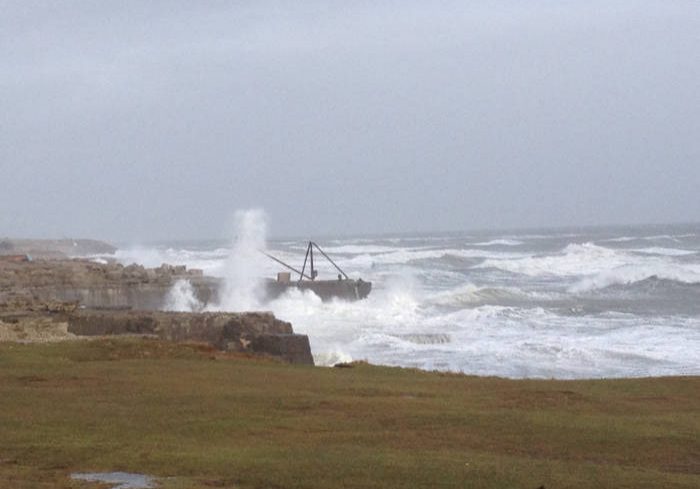
Above: Rough sea. No-one would snorkel in this.
Below: Looks nice - but can you see the tops of the waves? White horses beginning to form. And she's wearing a fleece. It will be cold.
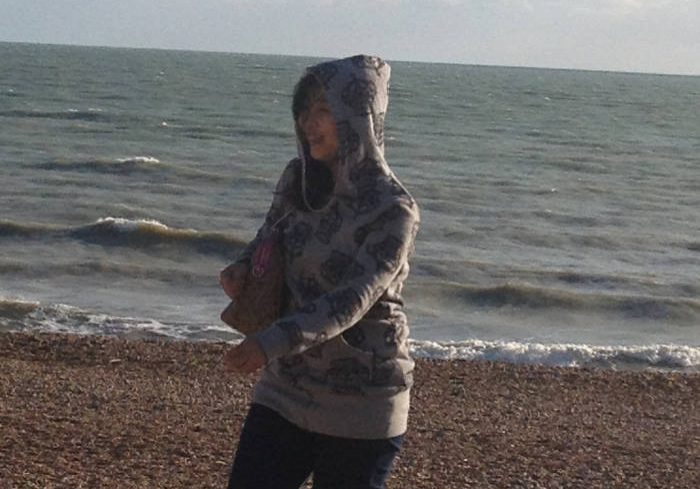
Look before you leap
So, it's worth checking out the sea before you go in. It can be done in a few seconds. It's simple. Just take a good look around.
Are there any flags flying? If they're red, don't go in. Look for warning signs on the beach.
Look at the waves: do they have white horses on the top? If they do, the wind’s a Force 4 and swimming's not a good idea. Do they crash onto the beach and suck back? There may be an undertow. Are people having trouble getting in and out? It might be the same for you.
Check out the boats on their moorings. Are they bouncing up and down a lot? Rough sea. Do they all point in the same direction? That's where the wind (and maybe a current) is coming from. Can you see any flags or pennants? They show wind direction. Are there any poles standing upright in the water? If there's water flowing round them they will show you if the tide’s coming in or going out - look at the direction the water’s flowing.
It's important to know where the wind’s coming from, because the wind might push you further than you want to go. It helps to know if the tide’s going out because it means you won't want to swim too far out - it might be tricky to get back. And - are the waves crashing onto the rocks? Keep away from there, you’ll be bashed.
None of these things take very long, if you're practised - it's like checking right and left before you cross the road. If you get a chance, ask someone local if it's safe to swim.
Don't think you have to go out, just because you’ve got a swimming costume on. For example, don't bother snorkelling in a rough sea - it might be exhilarating, but you won't be able to see anything and it's tricky breathing through a snorkel. And you might drown. Knowing when not to go out is helpful.
How to understand tides
On a planetary level, it's simple. Two-thirds of the planet is water, which is affected by the gravitational pull of the moon. The water is influenced by the moon as it circles the earth, so the water level shifts up and down on a regular basis.
It's a pattern, and you can predict when the water level is high or low. We call this high tide or low tide. Why does this matter to snorkellers? There are a couple of reasons. First is, if it's a very low tide, you might not be able to swim in it. 50 cms of water make for uncomfortable swimming. On the other hand, if it's high tide, there might be a lot of water around and it might be rather cold. Most people prefer swimming at high tide - but there are advantages in either.
The other reason, of course, is safety. If you imagine high tide being a bath full of water, and low tide as the same bath with 3cms of water, then you’re going to be in trouble if you're swimming near the plug-hole when the tide goes out. There's a lot of water moving past you very quickly.
In many places, of course, it doesn't really matter. In Weymouth, for instance, the tidal range - the difference between high and low tide - is two to three metres. You have to wade quite far out at low tide, but apart from that you don't really notice it.
In other places, it can be crucial. Avonmouth has a tidal range of 15 metres - that means that low tide can be 15 metres lower than high tide. You need to be aware of this when you're swimming.
Morecambe Bay is another example: although the sands are flat, the tidal range is about 10 metres and the tide can retreat up to 12 km before coming back in again. That's a lot of water coming in very quickly.There was a terrible incident in 2004 when 19 cockle-gatherers were caught by the incoming tide and drowned.
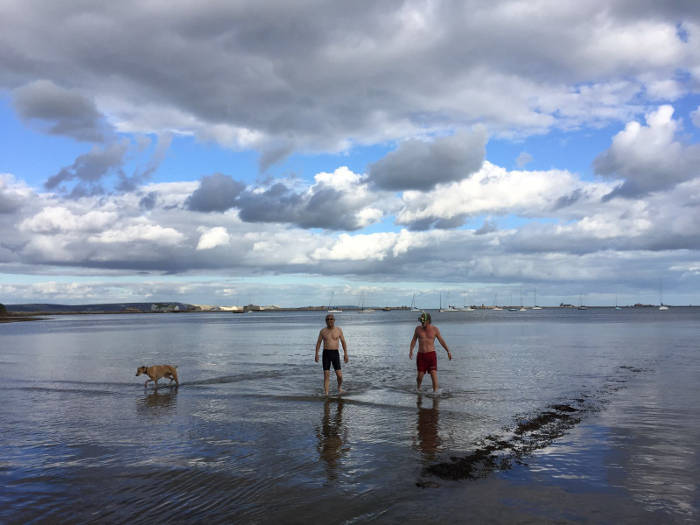
Above: Castle Cove, Weymouth. Low tidal range, shallow beach.
Below: Boats moored at the front all pointing in the same direction. That's where the wind or the current is coming from.
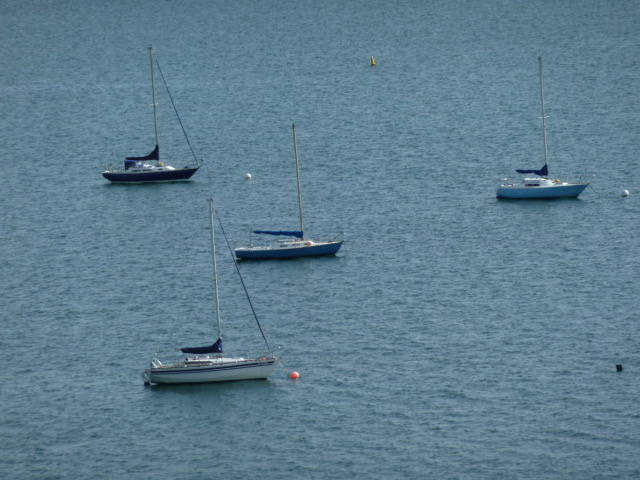
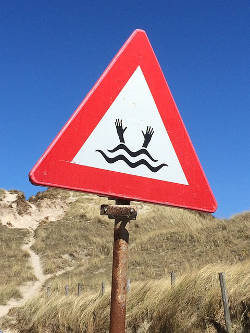
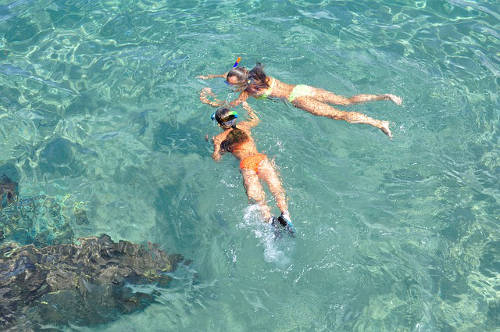
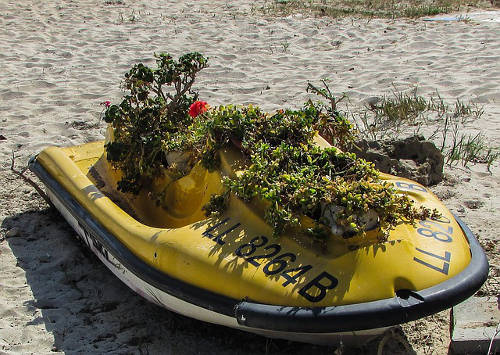
Swim back for safety
All this sounds alarmist, and it is. If there are problems with tides, they are usually signposted on the beach. And you can check tide tables if you want (see below), although we don't always bother locally, because we know the area. But here's a good practical tip: when you wade into the sea, stay in your depth, swim out five paces then TURN ROUND AND SWIM FIVE PACES BACK.
That way, if there's a tide running, or a current, you’ll feel it and take precautions. If it's a strong current, get out immediately, or stay near the shore with your feet on the ground. If it's a light current, swim into it. If you get tired or the current gets stronger, it should bring you back to where you started from (but keep an eye on it!). And if it's a current that's pulling you out to sea, just get out: it's not worth it. Go and have a cup of tea and come back another time - or go somewhere else.
The ‘turning round and swimming back’ advice is, by the way, a good thing to do throughout your snorkel trip. Stay aware of what's going on around you. The sea is always changing and moving. Don't be a passenger. Be a participant.
And while we’re on the subject of passengers - if you hear a sound like a sewing machine when you're in the water, it means there’s a boat around. Stick your head up and find it. Then track it until it's gone.
We know many boat owners, we had a half-share in a boat for fifteen years. 99% of them are responsible. It's the 1% you need to look out for, a dozy idiot in a speedboat or on a jet ski who won't see you until they run over you. But these, fortunately, are very very rare.
If you're worried about boats, keep near to the shoreline. Boats don't like going where it's shallow, as they’ll run aground. If you're in the middle of the sea and a boat is coming towards you, wave your arms and try to stand up straight in the water. You're quite low down and can be difficult to see.
If you're worried about jet skis, that's because you're an intelligent human being. Everyone should be worried about jet skis.
How to read a tide table
The best way to find the time of high tide is to say to a local, "What time's high tide?" then check by asking another one.
If you'd like to use tide tables, you need a bit more knowledge. It's true that the moon is the main mover of the tides, but there are lots of other factors too, most notably the sun.
The moon nears the earth, its gravity forces the sea onto the beach. It exerts this pressure twice a day - once from above the earth, and once from underneath - so you get two high tides a day.
Well, actually, the moon goes round the earth in the same direction that it rotates on its axis, which means it takes a bit longer. The moon circles the earth in 24 hours and fifty minutes, so you get a high tide once every 12 hours and 25 minutes (though this varies from place to place. In some parts of the world - for example, the Gulf of Mexico - you get only one high tide a day, for local reasons).
Anyway, the sun also plays a part. When the sun, earth and moon are in a straight line, there's a stronger gravitational pull and you get higher tides. These are called 'spring tides', because they spring up with greater energy. Spring tides happen during and after the new moon and the full moon.
(It's an unfortunate name. In Weymouth the council had a sign on the town bridge saying: WARNING: RISK OF FLOODING DURING SPRING TIDES. DO NOT PARK HERE. The tourists would drive up, and think "It's October. I'm OK". - and then come back to find their cars full of sea water. So, remember - spring tides mean twice a month. They don't mean March, April, May.)
In between the spring tides, the sun and the moon are at right angles to the earth, so the pull is much smaller. These are called 'neap tides' (neap is Anglo-Saxon for 'without power'). Now you have all the information you need.
On the right is a printed tide table for Weymouth, UK. It's for December, so you don't need to worry about Summer Time. The black circle next to 18 December means it's a new moon. The white circle next to 3 December means full moon. You'd expect high tides around here.
If you look at the figures next to 18 December, you can see 0636 - 2.1, and 11.26 - 0.5. This means the tide will be 2.1 metres higher than the average low tide at 6.36 a.m., and 0.5 metres higher at 11.26. Congratulations - you've worked out the high and low tide for the morning. American visitors should remember this is in metres, not feet. If you'd like more information, check out http://spin4bass.com/pages/tides.html
If you're looking for a website, we tend to use tides4fishing.com, which gives good information about today's tides and weather, and a lot more besides. You can see two screenshots on the right. This is a much easier and more informative way of checking what's going on.
Finally, remember the 'rule of twelfths'. When the tide turns - at high tide or low tide - you get a period of slack water. Then it starts to move. In the first hour, one-twelfth of the water comes in or goes out. In the next hour, two-twelfths, etc. So in the period midway between high tide and low tide, you'd expect most water to be moving.

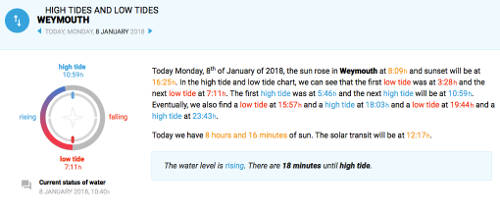
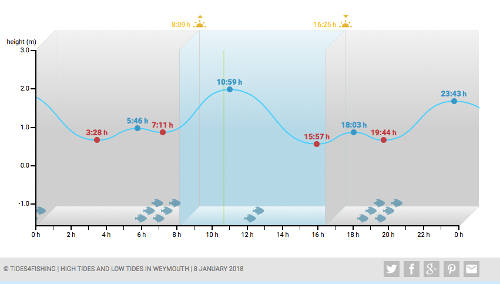
Finally - look but don't touch!
So, to summarise: to be safe in the sea, check out the conditions before you go in. Is it choppy, is it windy, can I see a current? If you think it's OK, make decisions - do I need shoes, or a rash vest, or a wetsuit?
Be aware all the time you are in the sea that things might change and you need to keep an eye on them. Watch out for currents, and boats, and being in the sun too long.
And finally - don’t touch! Most things in the sea are more frightened of you than you are of them, but if you push them into a corner they might fight back.
Further information
Royal Life Saving Society UK
http://www.rlss.org.uk/water-safety/water-safety/water-safety-at-the-beach/
BBC - How to stay safe at the beach and in the sea.
http://www.bbc.co.uk/news/uk-37152592
Royal National Lifeboat Institution (RNLI)
https://rnli.org/safety/beach-safety/beach-safety-advice
Wild swimming
http://www.wildswimming.co.uk/sea-safety/
Spin 4 Bass
spin4bass.com
Tides 4 fishing
tides4fishing.com all photos this page Gill Collins / Steve Elsworth
You may be interested in these other pages:
Do you have any comments? Please contact us. We'd love to hear from you!

Usual warning: we have made every effort to make sure this information is correct and up-to-date, but you need to check it all yourself.
© Garreg Lwyd Ltd 2018
